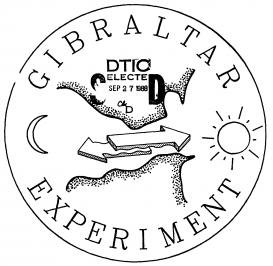The movie Das Boot followed the fictional German submarine U-96 as its captain tried to sail from the Atlantic into the Mediterranean to assist in the 1942 war effort. The major challenge was crossing the narrow Strait of Gibraltar, where the anxious crew was haunted by the “pings” of British active sonar. In 1981, the year the movie was released, NATO was immersed in oceanographic research at the Strait with the hope of enabling sonic detection of Soviet nuclear powered submarines. NATO’s Gibraltar Experiment soon became a landmark of research on global ocean circulation and climate change. The recent history of underwater surveillance at Gibraltar, a disputed territory at the heart of today’s European Union, brings together the geopolitics of the Global Cold War and deep ocean science, enabling new global visions of the Mediterranean Sea.
Nuclear powered submarines armed with nuclear warheads recruited the underwater world into a Cold War battlefield. Because an invisible enemy could emerge by surprise from any point of the world-ocean, combatants aspired to global surveillance. For that, they targeted chokepoints. Together with the northern GAP, the Strait of Gibraltar was the most strategic bottleneck for the US Navy to detect Soviet submarines going into the Atlantic. While the Strait’s narrowness presented an opportunity for mounting detection barriers, its depth and complex hydrology posed severe difficulties. These were matched by the political frictions existing around the Rock of Gibraltar - a British outpost bordering Francoist Spain, a non-NATO ally to the US – and North African decolonization.
This project explores the geopolitical and scientific resources mobilized in the effort of anti-submarine warfare at Gibraltar. Far from offering a US-centered perspective, it analyzes a number of transnational research programs and is very attentive to interests predating the Cold War, namely sovereignty disputes and decolonization. Underwater surveillance was a matter of acoustics. It required both the standardization of experience through trained ears and precise knowledge of sound propagation, which depended on Atlantic-Mediterranean water flows. The attention to circulation of civil and military oceanographers paved the way for the scientific globalization of the Mediterranean.
The Strait in the Cold War is a history of oceanography and Cold War geopolitics. It dives into the Strait of Gibraltar as a gateway between the Mediterranean at the Atlantic. The main thesis advanced in this project is that anti-submarine surveillance reunited geopolitics and ocean science in such a way that rendered the Cold War Mediterranean relevant to the creation of modern globalities. Specifically, oceanographers started to discuss the Mediterranean as both a factor in world ocean dynamics (for which they traced Mediterranean water masses as they crossed the Atlantic towards the North Pole) and a model basin to understand convection at a global scale. Anti-submarine surveillance required detailed knowledge of the behavior of deep currents. In particular, acoustic monitoring demanded new and changing ways of perceiving under water, from listening below the surface to seeing sound signatures in graphic patterns. And this new phenomenology gave shape to new objects, such as deep currents, scattering layers, the thermocline, plankton, and internal waves. These objects, and the technologies that made them possible, survived the Cold War and still shape the current environmental and political surveillance in the Mediterranean.
The Strait of Gibraltar was one of the busiest for commerce and military vessels throughout the 20th century. In the age of nuclear deterrence between the two superpowers and of north-African decolonization, being able to close or open that gateway between two oceans became a priority of government and military authorities of numerous countries. From the 1940s and well into the 1990s, scientists and navy officials from more than 10 nations endeavored to map converging currents. They did so through secret bilateral agreements as well as through transnational collaborative efforts such as the International Geophysical Year (1957-1958), the NATO Subcommittee for Oceanography (1959-1975), and the Gibraltar Experiment (1985-1995). In this account, the Strait becomes a chokepoint for the entangled histories of worldwide underwater surveillance and the construction of the global ocean in scientific and environmental senses.
Among the players in this story are some of the usual suspects in accounts of Cold War oceanography, particularly scientists and institutions from the US, the USSR and the UK. But the struggle for knowledge and power extended to scientific and diplomatic representatives of Spain, France, Italy, Morocco and Algeria. Their respective strategies included collaboration, hegemony and competition through expeditions, publication patterns, and funding decisions. The specificities of the Strait of Gibraltar’s hydrology and politics, together with its commonalities to other oceanic chokepoints, allowed it to become a focal point for the emergence of a new global world.

